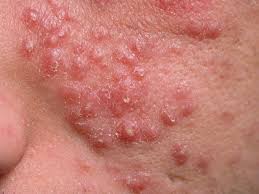Papules

Papules are a form of acne vulgaris that has small red bumps measuring between 0.5 centimeters and 1.5 centimeters in diameter. It rise above the skin, with the contained inflammation causing the red coloring and making the lesion tender to touch. It may appear alone or in groups.
Technically, the
bumps reveal no visible pores as in blackheads, and they are not white like
whiteheads. Instead, they are closed, red and surrounded by skin inflammation.
Typically it appear on the face, but may appear on other parts of the
body. It occurs when the wall of a hair follicle break and cave in. The
visible inflammation is due to white blood cells rushing in, however; they
contain no pus.
Causes
Although
it is not caused by "dirty" pores, acne papules are caused by clogged
pores. This type of
acne forms when a follicular wall breaks and white blood cells rush in to
confront bacteria, leading to inflammation. Overproduction of sebum, an oily
substance manufactured to lubricate the hair and skin, or an excess of dead
skin cells may clog hair follicles and lead to papule acne. Hormones, heredity,
bacteria, certain medications and even restrictive clothing may be responsible
for increased sebum production.
Formation of papules
It occurs when a
hair follicle becomes inflamed--this is different from other acne occurrences
such as whiteheads or blackheads, as these are caused by sebum blockages. This
inflammation can come as the result of sweating and friction to the skin; as a
reaction to extreme heat or medications; or even due to a genetic
predisposition toward forming papules. These bumps are often raised above the
skin, but may be flesh-colored and only noticeable by touch.
Features
- It can be differentiated from pustules by the fact that it contain no pus.
- They usually present themselves in clusters, most frequently with rashes.
- They often itch. The scratching this incites makes the elevations red and crusty.
- It may accompany a variety of conditions, some chronic and others acute.
- have round shapes, appear in red color.
- They are barely visible and measures
1to5 mm in diameter.
Prevention
- The key to preventing such acne is a clean face. Make sure you are washing twice a day with an acne-targeted cleanser followed by moisturizer.
- Wear sunscreen. Research has shown that
reducing sun exposure can also reduce inflammation, which can lead to
developing such acne.
Treatments
This type of acne may be treated
with over-the-counter topical creams and lotions, prescription drugs,
antibiotics, laser and light therapy, or cosmetic procedures such as chemical
peels and microdermabrasion. Topical acne treatments all attempt to kill
bacteria, dry up excessive oil and slough dead skin cells, thereby reducing the
risk of clogged follicles. For more severe cases of such acne, individuals
may require antibiotics to eliminate bacteria and fight inflammation.
Tags
acne vulgaris, blackheads, whiteheads, pustules, over-the-counter, topical, prescription drugs, laser and light therapy
Irresistible Acne Remedies. This free newsletter is delivered monthly, straight to your INBOX. It covers all new pages since the last issue. Sign up here...


New! Comments
Have your say about what you just read! Leave me a comment in the box below.